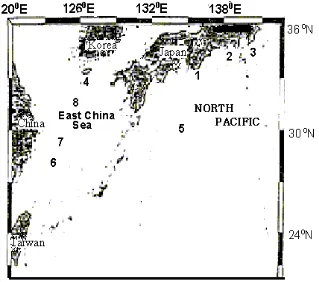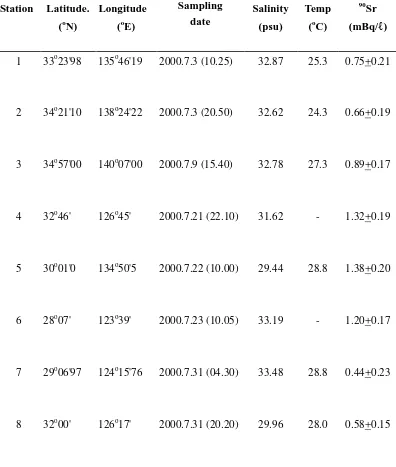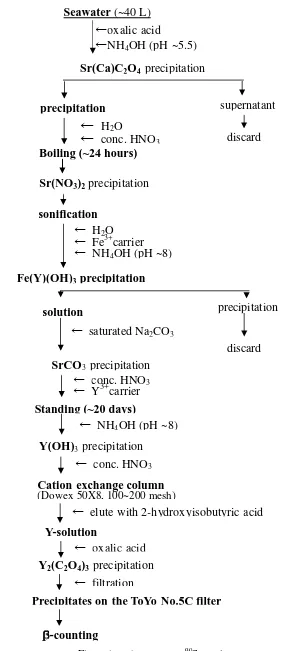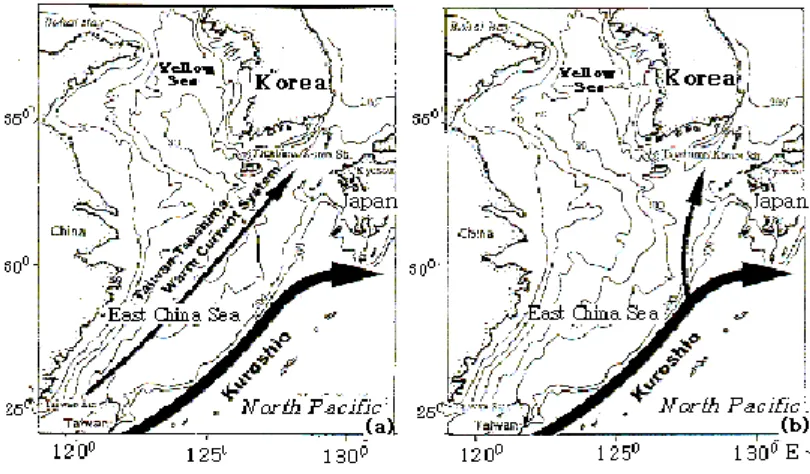90
Sr CONDITION IN THE EAST CHINA SEA AND NORTH
PACIFIC
Muslim*
Department of Marine Science Diponegoro University, Semarang 50275 - Indonesia
Received : April, 24, 2006 ; Accepted : June, 15, 2006
ABSTRACT
The condition of 90Sr concentration in the East China Sea and North Pacific closed to the Japanese island has been measured from 3 – 31 July 2000. There were differences condition of 90Sr concentration in the those locations. The concentration of 90Sr detected in the surface East China Sea and North Pacific ranged 0.44–1.32 mBq/ℓ and 0.66-1.38 mBq/ℓ respectively. Generally, the condition 90Sr concentration in the East China Sea was lower than in the North Pacific. The highest 90Sr concentration occurred in the off shore of North Pacific, because the 90Sr in the open sea is dominantly from nuclear weapon testing and nuclear power plant accident (Chernobyl) rather than other resources, and it take long time to precipitate into the bottom. Kuroshio and Taiwan-Tsushima warm current systems influenced importantly in distribution of 90Sr concentration in the East China Sea beside other physical factors such as fishing activity. These currents were not strong enough to stimulate increasing 90Sr concentration in the coastal region of North Pacific close to the Japanese islands.
Key word : 90Sr, East China Sea, North Pacific, currents, nuclear weapon testing
*Correspondence : Phone + 62-24-7474698, Fax +62-024-7474698, e-mail : muslim_muslim@yahoo.com
I
NTRODUCTION
The long-life artificial strontium-90 (half life 28.8 years) has been known as the most biologically hazardous radionuclides produces in nuclear fission processes. When it is introduced to environment will incorporate with calcium and eventually that calcium is consumed by humans together with this radionuclide. Generally, antropogenic radionuclides are controlled by horizontal advection, bottom topography of the ocean instead of deposition due to global fallout because major deposition of antropogenic radionuclides originating from the atmospheric nuclear testing.
Biogeochemical processes also contribute in the distribution of radionuclides
Sun, 1986). In addition Chen et al (1999) found that there were two favorable areas for explosive deepening, one over the east Sea of Japan, and the other over the northwestern Pacific, east and southeast of Japan. The latter was located close to the warm Kuroshio Current. This current and Tsushima current as a branch of the Kuroshio current are the most important currents in the waters around East China Sea and North Pacific. These currents flowing from the western North Pacific to
Japan Sea via East China Sea transports surface waters with higher 137Cs and 90Sr (Kasamatsu and Inatomi, 1998). Corresponded with these conditions, it is not surprising that much of scientists interested to study radionuclides in this area especially 90
Sr condition. The purpose of the present study is to know the condition of 90Sr in East China Sea and in the west of Japanese island as part of North Pacific associated with the condition of area.
M
ATERIALS AND
M
ETHODS
Collecting surface seawater was carried out at East China Sea and North Pacific closed to Japanese region (Fig. 1) from 3 – 31 July 2000 during the undergraduate training programme on the Marine Vessel Gaya, the training ship of Pukyong National University. About 40 ℓ of seawater was collected with a
submerged water pump. The samples were stored in two pre-cleaned 20 ℓ polyethylene bottles after acidification
.
90Sr analysis was done in the geochemistry oceanography laboratory of Pukyong National University, Busan, Korea. The flow chart of 90Sr analysis method is shown in the figure 2.
R
ESULTS AND
D
ISCUSSION
The result of analysis of salinity, temperature and 90Sr concentration in the various latitude bands around East China Sea and North Pacific, is shown in the Table 1.
Table 1. Salinity, temperature and 90Sr concentration in the East China Sea and North Pacific
Station Latitude.
(oN)
Longitude
(oE)
Sampling date
Salinity
(psu)
Temp
(oC)
90
Sr
(mBq/ℓ)
1 33o23'98 135o46'19 2000.7.3 (10.25) 32.87 25.3 0.75+0.21
2 34o21'10 138o24'22 2000.7.3 (20.50) 32.62 24.3 0.66+0.19
3 34o57'00 140o07'00 2000.7.9 (15.40) 32.78 27.3 0.89+0.17
4 32o46' 126o45' 2000.7.21 (22.10) 31.62 - 1.32+0.19
5 30o01'0 134o50'5 2000.7.22 (10.00) 29.44 28.8 1.38+0.20
6 28o07' 123o39' 2000.7.23 (10.05) 33.19 - 1.20+0.17
7 29o06'97 124o15'76 2000.7.31 (04.30) 33.48 28.8 0.44+0.23
Fig. 2. Flow chart for seawater 90Sr analysis
←
oxalic
acid
Y
2(C
2O
4)
3precipitation
Boiling (~24 hours)
Seawater
(~40 L)
←
oxalic
acid
←
NH4OH (pH
~5.5)
Sr(Ca)C
2O
4precipitation
precipitation
supernatant
←
H
2O
←
conc. HNO3
discard
Sr(NO
3)
2precipitation
sonification
←
H2O
←
Fe
3+carrier
←
NH4OH (pH ~8)
Fe(Y)(OH)
3precipitation
solution
precipitation
←
saturated Na2CO3
discard
SrCO
3precipitation
←
conc. HNO
3←
Y
3+carrier
Standing (~20 days)
←
NH4OH (pH
~8)
Y(OH)
3precipitation
←
conc. HNO
3Cation
exchange column
(
Dowex50X8, 100~200 mesh)
←
elute
with 2-hydroxyisobutyric
acid
Y-solution
←
filtration
Precipitates on
the ToYo
No.5C filter
β
β
β
The concentration of 90Sr in the surface seawater of East China Sea (station 4, 6, 7 and 8) were variable with ranged 0.44 -1.32 mBq/ℓ. There were lower than concentration in surface seawater of Japan Sea (averaged 1.386mBq/ℓ, Muslim in press). Concentration of 90Sr at station 6 was higher than at station 7, it due to that the station 6 located more southern and closer to mainland than station 7. The southern of East China Sea is a dynamic energy marginal sea based upon its geological, physical, chemical and biological features (Chen Lee, 1995; Hsueh et al 1992; Liu et al, 1992; Wong et al, 1991) and the Kuroshio current flows along the eastern coast of Taiwan and collides with the shoaling East China Sea Shelf when it approaches the northeastern tip of Taiwan
(Fig. 3 ). As result, it causes a variety of phenomena, one of which is development of a cyclonic eddy that exchanging seawater constituents between distinct water masses, particularly coastal water and offshore waters (Hayward and Mantyla, 1990) and it will effect on 90Sr concentration in the seawater at that location.
In addition, the high concentration of 90Sr at station 6, it may be that station was much more supported from Taiwan with through processes of the Taiwan-Tsushima Warm Current System (Fig. 4, Isobe, 1999). He found that there are two different schools of thought with regard to the origin the Tsushima Warm Current. One school of thought believes that it comes from the Taiwan Strait, while the other believes that it enters the East China Sea from the Kuroshio region southwest of Kyushu Japan, crossing the steep shelf slope.
The fate of 90Sr at station 4 and 8 were similar with 90Sr at station 6 and 7, but the kind of physical processes at those places were different, where Taiwan-Tsushima Warm Current System strongly occur at station 6 Maximum total current velocities exceed 100 cm/s in the surface layers. Beside that Kawatate et al, (1988) said that the fishing
and trawling activities in the interior of the Korea-Tsushima strait is very intense. From these conditions, the 90Sr at station 4 will increase may be as result of chemical leached from soil and sediments throughed physical processes.
Fig. 3. Schematic diagram of the current system in the East China Sea (Nitani,1972)
C
ONCLUSION
Condition of 90Sr concentration in the East China Sea is lower than Japan Sea and western Japanese island a part of North Pacific. The highest 90Sr concentration occurred in the open sea of North Pacific, it due to the source of 90Sr in the deep sea from global fallout of nuclear weapon testing and
nuclear power plant accident of Chernobyl rather than from other resources. Even
I would like to specially thank to the captain and crew of Gaya training ship for their help in seawater collecting during undergraduate student training of Pukyong National
University (PKNU), Busan, Korea. I also wish to thank members of Geochemistry Oceanography laboratory of PKNU for facilitating the data analysis.
R
EFERENCES
Bowen, V.T and Roether, W. 1973. Vertical distribution of strontium 90, cesium 137, and tritium near 450 North in Atlantic. J. Geophysic Res, 78: 6277-6285.
Chen Lee, Y.L. 1995. Temporal and spatial changes of chlorophyll a in the KEEP study waters off northeastern Taiwan. Terrestrial, Atmosphere. Oceanic Sci. 6, 607-620.
Chen, S.J., Kuo, Y.H., Zhang, P.Z and Bai, Q.F. 1999. Climatology of explosive cyclones off the east Asian coast. Monthly Weather Rev, 120(12), 3029-3055.
Duce, R.A., Arimoto; R., Ray; B.J., Unni, C.K and Harder, P.J. 1983. Atmospheric trace elements at Enewetak. J. Geophysic Res, 88: 5321-5342.
Gao, Y., Arimoto; R., Zhou, M.Y., Merril, J.T and Duce, R.A. 1992. Relationships between the dust concentrations over eastern Asia and the remote North Pacific. J. Geophysic Res. 97, 9867-9872.
Gao, Y., Arimoto; R., Duce, R.A., Chen, L.Q., Zhou, M.Y and Gu, D.Y. 1996.
Atmospheric non-sea-salt sulfate, nitrate and methanesulfonate over the China sea. J. Geophysic Res, 101, 12601-12611.
Gao, Y., Arimoto; R., Duce, R.A.,. Zhang, X.Y., Zhang, G.Y., An, Z.S., Chen, L.Q., Zhou, M.Y and Gu, D.Y. 1997. Temporal and spatial distribution of dust and its deposition to the China Sea. Tellus, 49B, 172-189.
Hsueh, Y., Wang, J and Chern, C.S. 1992. The intrusion of the Kuroshio across the continental shelf northeast of Taiwan. J. Geophysic Res, 97: 14,323-14,330.
Hayward, T.L and Mantyla, A.W. 1990. Physical, chemical and biological structure of a coastal eddy near Cape Mendocino. J. Mar Res, 48 : 825-850. Ikeuchi Y., Amono, H., Aoyama, M.,
radionuclides in seawater of the Far Eastern Seas. Sci. Tot. Environ. 237/238, 203-212.
Isobe A. 1999. On the origin of the Tsushima Warm Current and its seasonality. Cont. Shelf. Res. 19, 117-133.
Kanivets, V.V., Voitsekhovitch, O.V., Simov, V.G and Golubeva, Z.A. 1999. The Effective environmental half lives of 90
Sr and 137Cs in the coastal seawater of Japan. J. Geophysic. Res. 103, 1209-1217.
Kawatate, K.,. Miita, T., Ouchi, Y and Mizuno, S. 1988. A report on failures of current meter moorings set east of Tsushima Island from 1983 to 1987. Prog Oceanogr, 21, 319-327.
Liu, K.K., Gong, G.C., Shyu, C.Z., Pai, S.C., Wei, C.L and Chao, S.Y. 1992. Response of Kuroshio upwelling to the onset of northeast monsoon in the sea north of Taiwan: observation and a numerical simulation. J. Geophysic Res. 97, 12,511-12,526.
Livingstone, H.O and Povinec, P.P. 2000. Anthropogenic marine radioactivity. Ocean.Coast Man, 43, 689-712. Miyao, T., Hirose, K., Aoyama, M and
Igarashi, Y. 1998. Temporal feature of anthropogenic radionuclides, 137Cs and 239,240Pu in the Sea of Japan. J. Environ Radioac, 40, 239-250.
Muslim.The 90Sr concentration in surface seawaters of Japan Sea. J. Coasta. Dev. ( in press )
Nagaya, Y. and Nakamura, K. 1970. A study on the vertical transport of 90Sr and 137
Cs in the surface waters of the seas around Japan. J. Rad.Res., 11, 32-43. Nagaya, Y. and Nakamura, K. 1987.
Artificial radionuclides in the western Northwest Pacific (I) 90Sr and 137Cs in the deep waters. J. Oceanogr Soc Jap. 37, 135-144.
Nitani,, H. 1972. Beginning of the Kuroshio, in Kuroshio, edited by H. Stommel and K. Yoshida, pp. 129-163, Univ. of Tokyo press, Japan.
Oughton, D.H., Borretzen, P., Salbu, B and Tronstad, E. 1997. Mobilization of 137
Cs and 90Sr from sediments: potential sources to arctic waters. Sci Tot. Environ, 202, 155-165.
Teague, W.J., Perkins, H.T., Jacobs, G.A and. Book, J.W. 2001. Tide observations in the Korea-Tsushima strait. Cont Shelf. Res, 21, 545-561
Tsunogai, S., Watanabe, Y.W., Harada, K., Watanabe, S., Saito, S and Nakajima, M. 1993. Dynamic of the Japan Sea deep water studied with chemical and radiochemical tracers. Deep. Ocean. Circul, 105-119.



